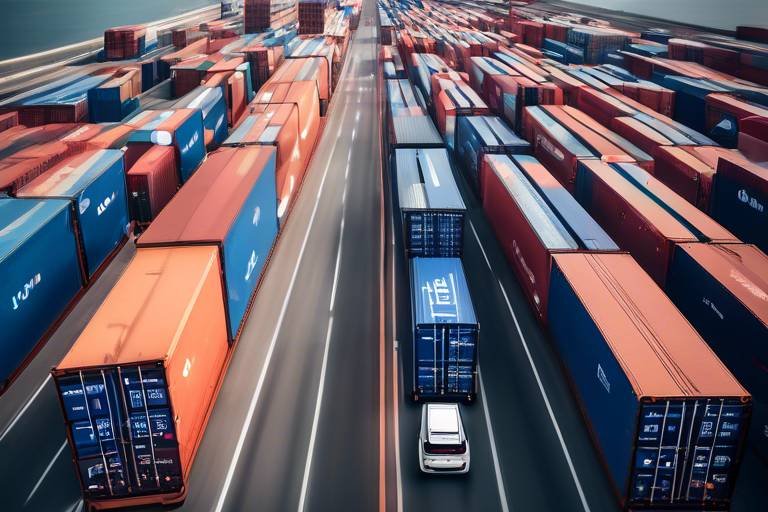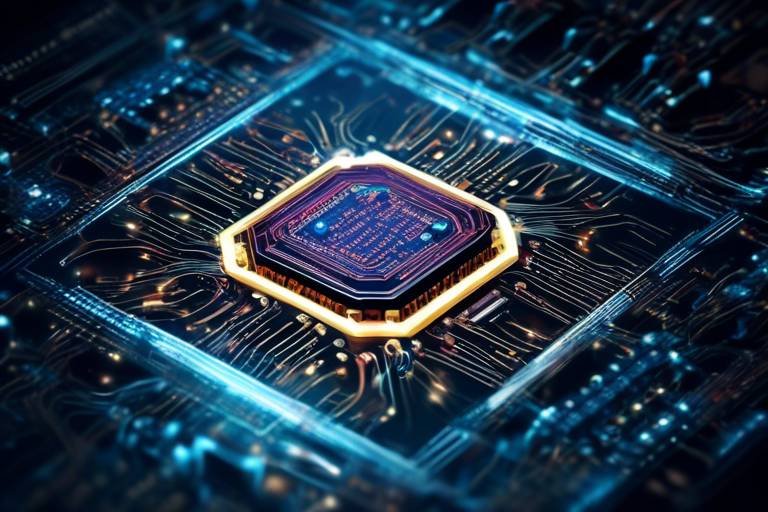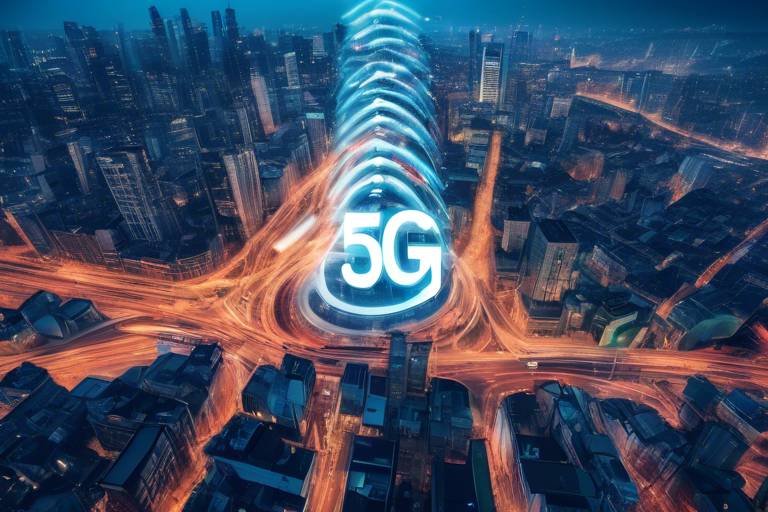Green Energy: Harnessing the Power of AI
In an era where climate change is at the forefront of global concerns, the quest for sustainable energy solutions has never been more critical. The fusion of green energy and artificial intelligence (AI) is revolutionizing how we approach energy production and consumption. Imagine a world where our energy systems are not only efficient but also smart enough to adapt to our ever-changing needs. This article delves into the exciting intersection of these two fields, showcasing how AI is paving the way for innovative solutions while also addressing the challenges that lie ahead.
AI technologies are transforming renewable energy sectors by optimizing energy production, managing resources, and predicting energy demands. Picture AI as the brain behind the operations, tirelessly analyzing data and making real-time decisions that lead to more efficient use of sustainable energy sources. From solar and wind to hydroelectric power, AI is enhancing the capabilities of these systems, ensuring that we harness every possible watt of energy. With its ability to process vast amounts of data quickly, AI can identify patterns and trends that humans might overlook, making it an invaluable tool in the fight for a greener planet.
Smart grids are a game-changer in the realm of energy distribution and consumption. By utilizing AI, these grids enhance efficiency and reliability, allowing for real-time monitoring and management of energy flow. This is crucial for integrating renewable energy sources, which can be unpredictable. Imagine a bustling city where every building is connected to a smart grid, capable of adjusting energy distribution based on real-time needs. This not only reduces waste but also ensures that renewable sources are utilized effectively, paving the way for a more sustainable future.
One of the most exciting applications of AI in green energy is the use of predictive analytics. This technology can forecast energy demand patterns, allowing for better resource allocation and reducing waste in energy production and consumption. Think of it as having a crystal ball that helps energy providers anticipate when and where energy will be needed most. By analyzing historical data and current trends, AI can help create a more balanced energy supply, ensuring that we meet our needs without overproducing.
At the heart of predictive analytics are machine learning algorithms. These sophisticated tools analyze vast datasets to identify trends and optimize energy generation and consumption. By continuously learning from new data, they can adapt to changes in energy use, improving the overall efficiency of renewable energy systems. This capability not only enhances performance but also reduces costs, making green energy more accessible to everyone.
Real-time data processing is another critical component of AI's role in green energy. It enables immediate adjustments in energy supply and demand, ensuring a balanced and efficient energy grid that incorporates renewable sources effectively. Imagine a scenario where a sudden spike in energy demand is met with an instant response from the grid, drawing on solar or wind power as needed. This level of responsiveness is crucial for maintaining stability in our energy systems.
AI is also enhancing energy storage technologies, allowing for better management of energy reserves. This is particularly important for addressing intermittency issues associated with renewable energy sources like solar and wind. With advanced AI algorithms, energy storage systems can predict when energy will be generated and stored, optimizing the use of resources and improving the viability of renewable energy. This means that even when the sun isn't shining or the wind isn't blowing, we can still rely on clean energy sources.
Despite the potential benefits, integrating AI into the green energy sector faces challenges. These include data privacy concerns, high implementation costs, and the need for skilled professionals. As we move forward, it's essential to address these hurdles to fully realize the potential of AI in creating a sustainable energy future.
As AI systems require large datasets, ensuring data privacy and security is crucial to protect sensitive information while promoting innovation in the green energy sector. Organizations must implement robust security measures to safeguard data, fostering trust among consumers and stakeholders alike.
The initial investment required for implementing AI technologies in renewable energy can be significant, posing a barrier for many organizations looking to transition to greener practices. However, as technology advances and becomes more affordable, we can expect to see a broader adoption of AI solutions in the energy sector.
The future of AI in green energy looks promising, with advancements in technology paving the way for more efficient, sustainable, and intelligent energy systems that can adapt to changing demands. As we continue to innovate, the possibilities are endless. The integration of AI in green energy is not just a trend; it's a revolution that will shape our energy landscape for generations to come.
- What is the role of AI in renewable energy?
AI optimizes energy production, manages resources, and predicts energy demands, enhancing the efficiency of renewable sources. - How do smart grids work?
Smart grids utilize AI for real-time monitoring and management of energy flow, improving distribution and consumption efficiency. - What are the challenges of integrating AI into green energy?
Challenges include data privacy concerns, high implementation costs, and the need for skilled professionals. - What is predictive analytics in energy?
Predictive analytics forecasts energy demand patterns, enabling better resource allocation and minimizing waste.

The Role of AI in Renewable Energy
Artificial Intelligence (AI) is revolutionizing the renewable energy sector, acting as a catalyst for change that enhances efficiency and sustainability. Imagine a world where energy sources like solar and wind are not only abundant but also optimized to meet our needs in real-time. This is not just a dream; it’s becoming a reality thanks to AI technologies. By leveraging sophisticated algorithms and data analytics, AI is enabling us to optimize energy production, manage resources more effectively, and predict energy demands with remarkable accuracy.
One of the most exciting aspects of AI in renewable energy is its ability to analyze vast amounts of data. For instance, AI can process weather patterns, historical energy consumption data, and even real-time inputs from smart devices. This capability allows energy producers to forecast energy generation from renewable sources, such as predicting how much energy a wind farm will produce based on wind conditions. The result? A more reliable and efficient energy supply that aligns closely with actual demand, minimizing waste and maximizing the use of clean energy sources.
Furthermore, AI is instrumental in the management of energy resources. It can optimize the performance of solar panels by adjusting their orientation based on the sun's position or by predicting when to store energy in batteries versus when to release it back into the grid. This dynamic management ensures that we are not just generating energy but using it in the most efficient manner possible. In essence, AI acts as the brain of renewable energy systems, making decisions that enhance productivity and sustainability.
Moreover, AI's role extends beyond just production and management; it also plays a crucial part in enhancing the user experience. Smart home technologies, powered by AI, allow consumers to monitor and control their energy usage more effectively. For example, AI can learn a household's energy consumption patterns and suggest ways to reduce usage during peak hours, ultimately leading to lower energy bills and a reduced carbon footprint. This not only benefits individual consumers but also contributes to a more stable and efficient energy grid.
In conclusion, the role of AI in renewable energy is multifaceted and transformative. By optimizing energy production, managing resources, and enhancing user experiences, AI is paving the way for a more sustainable future. As we continue to embrace these technologies, we can expect to see even more innovative solutions that will help us tackle the challenges of climate change and energy sustainability. The integration of AI into renewable energy systems is not just a trend; it's a necessary evolution that will shape the future of how we produce and consume energy.
- How does AI improve renewable energy efficiency? AI improves efficiency by analyzing data to optimize energy production and consumption, ensuring resources are used effectively.
- What are the benefits of using AI in energy management? Benefits include better forecasting of energy demands, enhanced resource management, and improved user experiences through smart technologies.
- Can AI help reduce energy costs? Yes, by optimizing energy use and suggesting ways to reduce consumption, AI can lead to significant savings on energy bills.
- What challenges does AI face in the renewable energy sector? Challenges include data privacy concerns, high implementation costs, and the need for skilled professionals to manage AI systems.

Smart Grid Technologies
In today's rapidly evolving energy landscape, are revolutionizing how we manage and consume energy. Imagine a network that not only delivers electricity but also communicates in real-time, adapting to our needs and optimizing energy use. This is the essence of smart grids, which leverage artificial intelligence to enhance the efficiency of energy distribution and consumption. By integrating advanced sensors, smart meters, and AI algorithms, smart grids enable a seamless flow of information, making it possible to monitor energy use dynamically and respond to fluctuations almost instantaneously.
One of the standout features of smart grid technologies is their ability to enhance energy distribution. Traditional grids often suffer from inefficiencies and outages, but smart grids can predict and mitigate these issues before they escalate. For instance, AI-driven systems can analyze historical data and current usage patterns to identify potential bottlenecks in the energy supply chain. This proactive approach not only minimizes disruptions but also maximizes the use of renewable energy sources, such as solar and wind, which are often variable in nature.
Moreover, smart grids facilitate better consumer engagement. With the help of smart meters, consumers can gain insights into their energy consumption habits. This transparency encourages more responsible energy use, as people can see how their choices impact their bills and the environment. For example, users might receive notifications during peak demand times, prompting them to adjust their usage and save money while also reducing strain on the grid. It’s like having a personal energy coach right in your home!
To illustrate the impact of smart grid technologies, consider the following table that summarizes key benefits:
| Benefit | Description |
|---|---|
| Improved Reliability | Reduces outages and improves response times to issues. |
| Enhanced Efficiency | Optimizes energy distribution and reduces waste. |
| Consumer Empowerment | Provides real-time data to consumers about their energy use. |
| Integration of Renewables | Facilitates the incorporation of renewable energy sources into the grid. |
As we look to the future, the potential of smart grid technologies is immense. They are not just about managing energy better; they are about creating a sustainable energy ecosystem. With AI at the helm, these technologies can learn and adapt, continuously improving their performance. Imagine a world where your home energy system communicates with your electric vehicle, optimizing charging times based on renewable energy availability. This is not just a dream; it's a glimpse into the future of energy management.
In conclusion, smart grid technologies represent a significant leap towards a more resilient and sustainable energy future. By harnessing the power of AI, we can create a system that not only meets our energy needs but does so in a way that is efficient, reliable, and environmentally friendly. The integration of these technologies is not merely a trend; it’s a necessary evolution in our approach to energy consumption and production.
- What are smart grids?
Smart grids are advanced electrical grids that use digital technology to monitor and manage the transport of electricity from all generation sources to meet the varying electricity demands of end users. - How do smart grids benefit consumers?
Smart grids provide consumers with real-time data about their energy consumption, allowing them to make informed decisions and potentially save on energy costs. - Can smart grids integrate renewable energy sources?
Yes, smart grids are designed to efficiently integrate renewable energy sources, helping to balance supply and demand while promoting sustainability.

Predictive Analytics for Energy Demand
Predictive analytics is revolutionizing the way we approach energy demand by leveraging the power of artificial intelligence to forecast consumption patterns. Imagine having a crystal ball that not only tells you how much energy will be needed tomorrow but also helps in planning the best way to deliver it. This is precisely what predictive analytics does—it analyzes historical data and identifies trends to predict future energy needs. By doing so, it allows energy providers to allocate resources more effectively, ensuring that supply meets demand without unnecessary waste.
At its core, predictive analytics utilizes sophisticated algorithms and machine learning techniques to sift through vast amounts of data. This data can include everything from weather patterns and seasonal changes to historical consumption trends and even social events that might spike energy usage. For instance, consider a hot summer day when everyone cranks up their air conditioning. Predictive analytics can help utilities anticipate this surge in demand and adjust their energy production accordingly, preventing outages and ensuring a smooth supply.
One of the most significant advantages of using predictive analytics in energy demand management is its ability to reduce waste. By accurately forecasting when and where energy will be needed, energy providers can minimize overproduction, which not only saves money but also reduces the environmental impact of generating excess energy. This leads to a more sustainable approach to energy consumption, aligning perfectly with the goals of green energy initiatives.
Moreover, predictive analytics enhances the integration of renewable energy sources into the grid. Since renewable energy production can be intermittent—think of solar panels generating power only when the sun shines—having a reliable forecast of energy demand allows for better planning. Energy providers can store excess energy generated during peak production times and release it during periods of high demand, creating a more resilient and efficient energy system.
To illustrate the impact of predictive analytics, consider the following table that summarizes its benefits:
| Benefit | Description |
|---|---|
| Improved Resource Allocation | Allows for better distribution of energy resources based on predicted demand. |
| Cost Savings | Reduces the need for excess energy production, lowering operational costs. |
| Enhanced Sustainability | Minimizes waste and supports environmentally friendly energy practices. |
| Increased Reliability | Helps prevent outages by anticipating energy needs during peak times. |
In conclusion, the integration of predictive analytics into energy demand management not only enhances efficiency but also supports the overarching goal of creating a sustainable energy future. By predicting consumption patterns accurately, energy providers can ensure that they meet the needs of their customers while minimizing their environmental footprint. As we continue to innovate and adopt new technologies, the role of predictive analytics will undoubtedly grow, paving the way for smarter energy systems that are better equipped to handle the challenges of tomorrow.
- What is predictive analytics? Predictive analytics is a branch of advanced analytics that uses historical data, machine learning, and statistical algorithms to forecast future events.
- How does predictive analytics benefit energy providers? It helps energy providers optimize resource allocation, reduce costs, and enhance sustainability by accurately forecasting energy demand.
- Can predictive analytics improve renewable energy integration? Yes, by anticipating energy demand, it allows for better management of renewable energy sources, addressing their intermittent nature.
- What technologies are used in predictive analytics? Technologies include machine learning algorithms, data mining, and statistical modeling.

Machine Learning Algorithms
Machine learning algorithms are revolutionizing the way we approach energy generation and consumption. By leveraging large datasets, these algorithms can identify patterns and trends that human analysts might overlook. Imagine a detective piecing together clues from a crime scene; similarly, machine learning sifts through data to uncover critical insights that can optimize renewable energy systems. For instance, by analyzing historical energy consumption data, machine learning models can predict future energy needs with remarkable accuracy, allowing for proactive adjustments in energy generation.
One of the most exciting aspects of machine learning in the energy sector is its ability to improve efficiency in real-time. With algorithms that continuously learn from new data, energy producers can adjust their output based on current demand, weather conditions, and even consumer behavior. It’s like having a personal assistant who not only knows your schedule but also anticipates your needs before you even ask! This adaptability is crucial for integrating renewable sources like solar and wind energy, which can be unpredictable due to their reliance on environmental conditions.
Moreover, machine learning can also enhance predictive maintenance in energy systems. By analyzing operational data from wind turbines or solar panels, algorithms can forecast potential failures before they occur. This proactive approach minimizes downtime and maximizes energy output, ensuring that renewable energy sources are utilized to their fullest potential. The table below summarizes some key machine learning applications in the renewable energy sector:
| Application | Description |
|---|---|
| Demand Forecasting | Predicts energy needs using historical consumption data. |
| Resource Optimization | Improves efficiency in energy production and distribution. |
| Predictive Maintenance | Anticipates equipment failures to reduce downtime. |
| Energy Trading | Analyzes market trends for optimal trading decisions. |
In conclusion, the integration of machine learning algorithms into the renewable energy landscape is not just a trend; it’s a transformative shift that promises to make energy systems smarter, more efficient, and more sustainable. As we continue to harness the power of AI, we can expect to see even more innovative solutions that will help us meet our energy needs while minimizing our impact on the planet.
- What are machine learning algorithms?
Machine learning algorithms are systems that learn from data to identify patterns and make predictions without being explicitly programmed for specific tasks.
- How do machine learning algorithms improve energy efficiency?
By analyzing vast amounts of data, these algorithms can optimize energy production and distribution, predict demand, and enhance maintenance schedules.
- Can machine learning help with renewable energy integration?
Absolutely! Machine learning can forecast energy supply and demand, making it easier to balance renewable energy sources with traditional power grids.

Real-time Data Processing
In the fast-paced world of energy management, stands out as a game-changer. Imagine a bustling city where every flick of a switch, every spark of energy, is monitored instantly. This is the essence of real-time data processing in the green energy sector. By harnessing the power of artificial intelligence (AI), energy providers can make immediate adjustments to supply and demand, ensuring a seamless flow of energy that is both efficient and sustainable.
At its core, real-time data processing allows for the immediate analysis of vast amounts of data generated from various energy sources. This capability is crucial for integrating renewable energy sources like solar and wind, which can be unpredictable. For instance, when a sudden gust of wind increases energy production from a wind farm, real-time data processing enables grid operators to respond quickly, redistributing energy to areas with higher demand. This not only maximizes efficiency but also minimizes waste, ensuring that every bit of generated energy is utilized effectively.
Consider this: if a city experiences a spike in energy demand due to a summer heatwave, real-time data processing can trigger a series of automated responses. Energy storage systems can release stored energy, while less critical loads can be temporarily reduced. This dynamic adjustment is akin to a conductor leading an orchestra, ensuring that every instrument plays in harmony, creating a beautiful symphony of energy management.
Furthermore, the integration of real-time data processing with smart grid technologies allows for enhanced monitoring and management of energy flows. Operators can visualize energy data through advanced dashboards, making it easier to identify trends and anomalies. This level of insight is invaluable for optimizing energy distribution and ensuring that renewable sources are effectively incorporated into the grid.
However, the implementation of real-time data processing is not without its challenges. The need for robust infrastructure and advanced analytics tools can be a barrier for many organizations. Yet, the potential benefits far outweigh these hurdles. By investing in real-time data processing capabilities, energy providers can not only improve their operational efficiency but also contribute to a more sustainable energy future.
- What is real-time data processing in the context of green energy?
Real-time data processing refers to the immediate analysis and response to data generated from energy sources, allowing for quick adjustments in energy supply and demand.
- How does AI contribute to real-time data processing?
AI enhances real-time data processing by analyzing vast datasets quickly, identifying trends, and facilitating automatic adjustments to energy flows.
- What are the benefits of real-time data processing for renewable energy?
It maximizes efficiency, minimizes waste, and ensures that renewable energy sources are effectively integrated into the energy grid.
- What challenges exist in implementing real-time data processing?
Challenges include the need for advanced infrastructure, high initial costs, and the requirement for skilled professionals to manage these systems.

Energy Storage Solutions
In the quest for a sustainable future, play a pivotal role. As we harness renewable energy sources like solar and wind, the challenge arises: how do we store this energy for use when the sun isn’t shining or the wind isn’t blowing? This is where the magic of artificial intelligence steps in, enhancing our ability to manage and optimize energy storage systems. Imagine a world where your home can store excess energy generated during the day and use it when you need it most—this is becoming a reality thanks to advancements in AI technology.
AI is revolutionizing energy storage by improving the efficiency and effectiveness of various storage technologies. For example, batteries are one of the most common forms of energy storage. AI can predict when energy demand will spike and manage the charge and discharge cycles of batteries accordingly. This ensures that energy is available when it’s needed, reducing waste and enhancing the overall reliability of renewable energy systems.
Moreover, AI algorithms can analyze performance data from energy storage systems to identify trends and make recommendations for improvements. This might include optimizing the size of the storage system based on predicted energy usage or suggesting maintenance schedules to prolong the life of the batteries. The integration of machine learning allows for continual learning and adaptation, making energy storage systems smarter over time.
To illustrate the impact of AI on energy storage, consider the following table that highlights different types of energy storage solutions and how AI enhances their functionality:
| Energy Storage Type | AI Enhancement |
|---|---|
| Battery Storage | Predictive analytics for charge/discharge cycles |
| Pumped Hydro Storage | Real-time monitoring for optimal water flow management |
| Flywheel Energy Storage | Efficiency optimization through performance analysis |
| Thermal Energy Storage | Demand forecasting to adjust heating/cooling cycles |
Additionally, AI can help tackle the intermittency issues associated with renewable energy. By predicting energy production from renewable sources and aligning it with energy storage capabilities, AI ensures that energy is available when needed. This not only enhances grid stability but also encourages more people to adopt renewable energy solutions, knowing that they can rely on efficient storage systems.
In conclusion, the integration of AI in energy storage solutions is not just a trend; it’s a necessity for a sustainable energy future. By optimizing how we store and use energy, we can overcome some of the biggest challenges facing the renewable energy sector today. As we continue to innovate and improve these technologies, the dream of a fully sustainable energy system becomes increasingly attainable.
- What are energy storage solutions? Energy storage solutions refer to various technologies that store energy for later use, such as batteries, pumped hydro, and thermal storage.
- How does AI improve energy storage? AI enhances energy storage by predicting demand, optimizing charge/discharge cycles, and analyzing performance data for continual improvement.
- Why is energy storage important for renewable energy? Energy storage is crucial for renewable energy because it helps manage the intermittent nature of sources like solar and wind, ensuring a reliable energy supply.

Challenges in AI and Green Energy Integration
Integrating artificial intelligence (AI) into the green energy sector is not without its hurdles. While the potential for innovation and efficiency is enormous, several challenges must be addressed to fully realize the benefits of this synergy. One of the most pressing issues is data privacy and security. As AI systems thrive on large datasets, the risk of exposing sensitive information becomes a significant concern. Companies must navigate the delicate balance between harnessing data for improved energy solutions and safeguarding the privacy of individuals and organizations. It's like walking a tightrope; one wrong step could lead to a fall.
Another challenge is the cost of implementation. Transitioning to AI-driven solutions often requires substantial initial investments in technology and infrastructure. This financial barrier can deter many organizations, especially smaller ones, from adopting these innovative practices. Imagine trying to upgrade your home with the latest smart technology, but the price tag makes you think twice. This is the reality for many in the renewable energy sector, where the cost of AI integration can seem daunting.
Additionally, the green energy sector faces a significant skills gap. There is a pressing need for professionals who are not only trained in AI technologies but also understand the intricacies of renewable energy systems. This shortage of skilled workers can slow down the pace of innovation and hinder the effective implementation of AI solutions. It's akin to having a cutting-edge sports car but lacking the skilled driver to navigate it effectively.
Moreover, there are regulatory challenges that can complicate the integration of AI in green energy. Governments and regulatory bodies are still catching up with the rapid advancements in technology, often resulting in outdated policies that do not accommodate the nuances of AI. This can create an environment of uncertainty, where companies hesitate to invest in new technologies for fear of falling foul of regulations. To put it simply, it's like trying to play a game with rules that keep changing.
Despite these challenges, the landscape is evolving. Companies are increasingly aware of the need to address these issues head-on. Collaborative efforts between tech firms, energy providers, and regulatory bodies are essential to create frameworks that support the integration of AI into green energy. By fostering an environment of innovation while ensuring data privacy, managing costs, and developing the necessary skill sets, we can pave the way for a more sustainable future.
- What are the main challenges of integrating AI into green energy?
The primary challenges include data privacy and security, high implementation costs, a shortage of skilled professionals, and regulatory hurdles.
- How does data privacy impact AI in green energy?
AI systems require large datasets, which raises concerns about the protection of sensitive information and compliance with privacy regulations.
- Why is the cost of implementation a barrier?
The initial investments needed for AI technologies can be significant, making it difficult for smaller organizations to adopt these innovations.
- What is being done to address the skills gap?
Collaboration between educational institutions and industry leaders is crucial to develop training programs that equip professionals with the necessary skills.

Data Privacy and Security
In the rapidly evolving landscape of green energy, data privacy and security have emerged as paramount concerns. With AI systems leveraging vast amounts of data to enhance energy efficiency and sustainability, the need to protect sensitive information cannot be overstated. Imagine a world where your energy consumption habits are analyzed and stored without your consent; it’s a scenario many of us would find unsettling. Therefore, understanding the implications of data privacy in the realm of AI and green energy is not just important—it's essential.
As the integration of AI technologies continues to grow, organizations must navigate the delicate balance between utilizing data for innovation and safeguarding personal information. Here are some key considerations:
- Data Collection Practices: Companies need to be transparent about what data they collect and how it will be used. Clear policies can help build trust with consumers.
- Regulatory Compliance: Adhering to data protection regulations such as GDPR (General Data Protection Regulation) is crucial. Organizations must ensure that their AI systems comply with these legal frameworks to avoid hefty fines.
- Encryption and Security Measures: Implementing robust security protocols to encrypt sensitive data can mitigate risks associated with data breaches. This includes using advanced technologies to protect data both in transit and at rest.
Furthermore, the challenge of data privacy extends beyond just compliance and security measures. It also involves ethical considerations surrounding the use of AI. For instance, how do we ensure that AI systems do not inadvertently perpetuate biases or misuse personal data? This is where ethical frameworks and guidelines come into play, guiding organizations in the responsible use of AI technologies.
In summary, while AI holds incredible potential for revolutionizing the green energy sector, the importance of data privacy and security cannot be overlooked. As we move forward, it is imperative that organizations prioritize these aspects to foster a sustainable and trustworthy energy ecosystem. Only then can we fully harness the power of AI in creating a greener future without compromising individual privacy.
- What is data privacy in the context of AI and green energy?
Data privacy refers to the proper handling, processing, and storage of personal information collected by AI systems in the green energy sector. - Why is data security important in renewable energy?
Data security protects sensitive information from unauthorized access and breaches, ensuring that consumer trust is maintained while promoting innovation. - How can organizations ensure compliance with data protection laws?
Organizations can ensure compliance by implementing robust data governance frameworks, conducting regular audits, and training staff on data protection best practices.

Cost of Implementation
Implementing AI technologies in the green energy sector can feel like standing at the base of a towering mountain. The view of the summit is breathtaking, filled with promises of efficiency and sustainability, but the climb to get there can be steep and challenging. One of the most significant hurdles organizations face is the . This encompasses not just the initial investment in technology but also the ongoing expenses related to maintenance, training, and integration.
To put it into perspective, let's break down some of the key factors contributing to the overall cost:
- Infrastructure Upgrades: Many existing energy systems need significant upgrades to accommodate AI technologies. This can involve installing new hardware, software, and communication systems that facilitate data flow and processing.
- Software Costs: The software that powers AI algorithms can be expensive. Licensing fees for advanced analytics platforms or machine learning tools can add up quickly.
- Training and Skill Development: For AI to be effectively integrated, staff members must be trained. This can mean hiring new talent or investing in training programs for current employees, both of which can be costly.
- Data Management: AI thrives on data. Organizations may need to invest in data collection and management systems to ensure they have the necessary information for their AI applications.
Moreover, the financial burden doesn't end with the initial setup. Organizations must also consider the long-term operational costs. Maintaining AI systems requires continuous updates and monitoring, which can involve hiring specialized personnel or outsourcing to tech firms. These ongoing costs can be daunting, especially for smaller companies or those with limited budgets.
Despite these challenges, the potential return on investment (ROI) can be significant. By optimizing energy production and consumption, organizations can reduce waste and lower operational costs over time. In fact, many companies that have embraced AI in their energy systems report substantial savings that eventually offset their initial expenditures.
In conclusion, while the cost of implementing AI in green energy can be a barrier, it is essential to view this investment as a pathway to a more sustainable and efficient future. As technology continues to evolve and become more accessible, the financial landscape may shift, making these solutions more attainable for a broader range of organizations.
Q1: What are the initial costs associated with implementing AI in green energy?
A1: Initial costs can include infrastructure upgrades, software licensing fees, training programs, and data management systems. These can vary widely based on the size and scope of the project.
Q2: Are there any long-term savings associated with AI implementation?
A2: Yes, many organizations report significant savings in operational costs due to optimized energy production and reduced waste, which can offset the initial investment over time.
Q3: How can small companies afford AI technologies?
A3: Small companies can explore partnerships, grants, or government incentives aimed at promoting green energy solutions, which can help alleviate some of the financial burdens associated with AI implementation.

Future Trends in AI and Green Energy
The future of AI in the realm of green energy is not just bright; it’s practically glowing with potential. As we continue to innovate and evolve, the integration of artificial intelligence into renewable energy systems is set to revolutionize how we produce, distribute, and consume energy. Imagine a world where energy systems are not only efficient but also smart enough to adapt to our needs in real time. Sounds like science fiction, right? Well, it’s closer than you think!
One of the most exciting trends is the development of intelligent energy management systems. These systems leverage AI to analyze consumption patterns, predict demand, and optimize energy distribution. For instance, AI can forecast peak usage times and automatically adjust energy flow, ensuring that we’re not wasting precious resources. This level of efficiency could significantly reduce our carbon footprint while also saving money on energy bills.
Moreover, the rise of decentralized energy grids is another trend to watch. With the help of AI, communities can generate and share their own energy through microgrids. This not only enhances energy security but also empowers individuals to take control of their energy consumption. Imagine being able to sell excess energy generated by your solar panels back to the grid! It’s a win-win situation that promotes sustainability and community collaboration.
Furthermore, advancements in energy storage technologies are crucial for the future of green energy. AI is playing a pivotal role in improving battery management systems, ensuring that energy is stored efficiently and used effectively. By optimizing charge and discharge cycles, AI can help mitigate the challenges posed by the intermittent nature of renewable sources like solar and wind. This means that even when the sun isn’t shining or the wind isn’t blowing, we’ll still have reliable energy at our fingertips.
Another promising area is the integration of blockchain technology with AI in green energy. Blockchain can enhance transparency and security in energy transactions, while AI can analyze the data generated, leading to smarter decision-making. This combination could revolutionize how we trade energy, making it more accessible and efficient for everyone.
As we look ahead, the collaboration between AI and green energy will likely lead to the creation of smart cities. These urban areas will utilize AI to manage energy consumption across various sectors, from transportation to residential buildings. Imagine a city where traffic lights adjust based on real-time energy availability or buildings that automatically optimize their energy use based on predictive analytics. It’s not just a dream; it’s a future that’s rapidly approaching.
In conclusion, the intersection of AI and green energy is set to create a more sustainable and efficient world. As technology continues to advance, we can expect to see innovative solutions that not only address current energy challenges but also pave the way for a greener future. The possibilities are endless, and we’re just scratching the surface of what’s possible!
- What is the role of AI in renewable energy?
AI optimizes energy production, manages resources, and predicts energy demands, leading to more efficient use of renewable energy sources. - How does AI improve energy storage solutions?
AI enhances energy storage technologies by improving the management of energy reserves and addressing intermittency issues. - What challenges does AI face in the green energy sector?
Key challenges include data privacy concerns, high implementation costs, and the need for skilled professionals. - What are smart grids?
Smart grids utilize AI for real-time monitoring and management of energy flow, enhancing the efficiency of energy distribution and consumption.
Frequently Asked Questions
- What is the role of AI in renewable energy?
AI plays a crucial role in renewable energy by optimizing production, managing resources, and predicting energy demand. This leads to more efficient utilization of sustainable energy sources, ultimately helping to reduce waste and improve overall energy efficiency.
- How do smart grids enhance energy efficiency?
Smart grids utilize AI technologies to monitor and manage energy distribution in real-time. This allows for immediate adjustments in energy flow, ensuring that renewable sources are integrated effectively and reducing losses in energy consumption.
- What are predictive analytics in energy demand?
Predictive analytics use AI to forecast energy demand patterns based on historical data. By understanding these trends, energy providers can allocate resources better, which minimizes waste and ensures that supply meets the actual demand.
- How do machine learning algorithms improve energy systems?
Machine learning algorithms analyze vast datasets to identify trends and optimize both energy generation and consumption. This results in improved efficiency and effectiveness of renewable energy systems, making them more reliable and sustainable.
- What challenges does AI face in green energy integration?
Integrating AI into the green energy sector presents challenges such as data privacy concerns, high implementation costs, and the need for skilled professionals. These barriers can slow down the adoption of innovative AI solutions in renewable energy.
- How does AI address energy storage issues?
AI enhances energy storage technologies by improving the management of energy reserves. This is particularly important for addressing intermittency issues associated with renewable energy sources, ensuring a steady supply even when generation fluctuates.
- What are the future trends for AI in green energy?
The future looks bright for AI in green energy, with continuous advancements leading to more efficient, sustainable, and intelligent energy systems. These systems will be capable of adapting to changing demands, making them essential for a greener future.



















